ABSTRACT - DRUM - University of Maryland
ABSTRACT - DRUM - University of Maryland
ABSTRACT - DRUM - University of Maryland
Create successful ePaper yourself
Turn your PDF publications into a flip-book with our unique Google optimized e-Paper software.
We then demonstrate that in a finite-size system the Majorana edge states lead to<br />
(nearly) degenerate ground states with different fermion parity on each chain, thus<br />
revealing its analogy with the Majorana edge states in non-interacting TSC. The<br />
degeneracy is shown to be robust to any weak intra-chain perturbations, but interchain<br />
single-particle tunneling and backscattering can possibly lift the degeneracy.<br />
We also discuss a lattice model where such field theory is realized at low energy.<br />
7.1 Field-Theoretical Model<br />
We start from an effective field-theoretical description <strong>of</strong> the model for the<br />
purpose <strong>of</strong> elucidating the nature <strong>of</strong> the Majorana edge states. We label the two<br />
chains by a = 1, 2. The low-energy sector <strong>of</strong> spinless fermions on each chain is well<br />
captured by two chiral Dirac fermions ˆψ L/R,a (x). The non-interacting part <strong>of</strong> the<br />
Hamiltonian is simply given by Ĥ0 = ∫ dx Ĥ0(x) where<br />
Ĥ 0 = −iv F<br />
∑<br />
a<br />
(<br />
ˆψ†<br />
Ra ∂ ˆψ x Ra − ˆψ † La ∂ ˆψ<br />
)<br />
x La . (7.1)<br />
Four-fermion interactions can be categorized as intra-chain and inter-chain interactions.<br />
Intra-chain scattering processes (e.g., forward and backward scattering)<br />
are incorporated into the Luttinger liquid description <strong>of</strong> spinless fermions and their<br />
effects on the low-energy physics are completely parameterized by the renormalized<br />
velocities v a and the Luttinger parameters K a . We assume that the filling <strong>of</strong> the<br />
system is incommensurate so Umklapp scattering can be neglected. For simplicity<br />
we assume the two chains are identical so v 1 = v 2 = v, K 1 = K 2 = K.<br />
We now turn to inter-chain interactions. Those that can be expressed in terms<br />
129
















